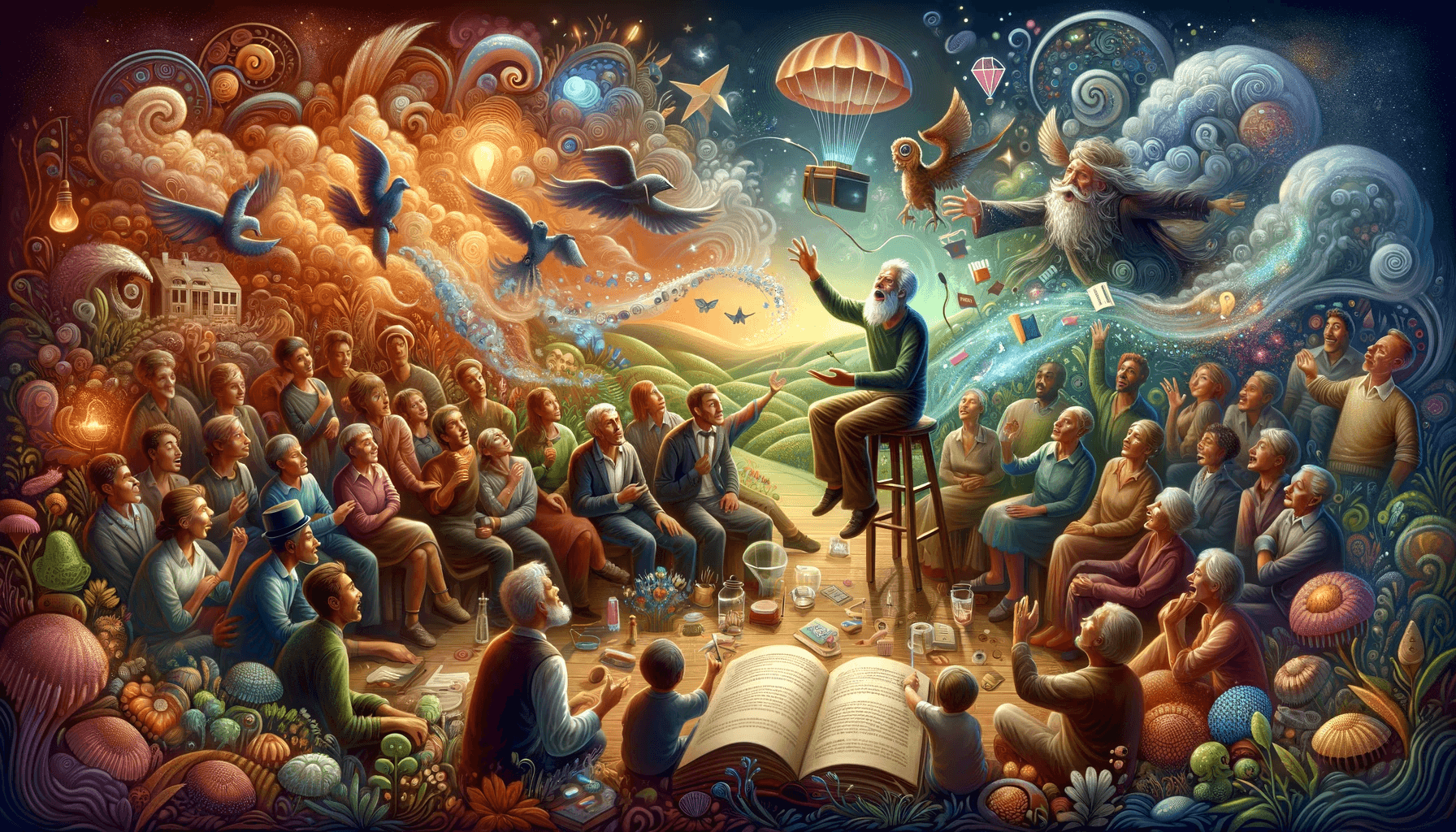Sponsor Einstein Success Code
Table of Contents
Introduction to the Art of Storytelling
Storytelling has been an integral part of human culture for thousands of years. From ancient cave paintings to modern-day novels and movies, stories have captivated and inspired us. The art of Storytelling is not only a form of entertainment but also a powerful tool for communication, connection, and understanding. In this article, we will explore the key elements of crafting engaging and memorable tales that leave a lasting impact on the audience.
The Power of Storytelling
Stories can transport us to different worlds, evoke emotions, and ignite our imagination. They can make us laugh, cry, or feel inspired. When we listen to a well-crafted story, our brains become engaged and more likely to remember the information being conveyed. Storytelling activates multiple brain areas, including language processing, sensory perception, and emotional responses. By harnessing the power of Storytelling, we can create a deeper connection with our audience and make our messages more memorable.
The Elements of a Compelling Story
To craft a compelling story, it is important to understand the key elements that make a narrative engaging. These elements include a well-defined plot, relatable characters, conflict, tension, and resolution. The plot is the story’s backbone, providing a structure for unfolding events and actions. It should have a clear beginning, middle, and end, with each part building upon the previous one.
Characters play a crucial role in Storytelling, allowing the audience to connect emotionally with the narrative. Well-developed characters have distinct personalities, motivations, and flaws. They should undergo a transformation or growth throughout the story, making them relatable and allowing the audience to root for them.
Conflict and tension are essential for keeping the audience engaged. Whether it is a physical battle, an internal struggle, or a clash of ideals, conflict creates obstacles that the characters must overcome. This keeps the audience on the edge of their seats, eager to see how the story unfolds. Finally, a satisfying resolution brings closure to the narrative, resolving the conflict and leaving the audience with a sense of fulfillment.
Understanding Your Audience
One of the most important aspects of Storytelling is understanding your audience. Every story should be tailored to the listeners’ or readers’ specific needs, interests, and preferences. Consider who your target audience is and what they value. Are they children, teenagers, or adults? Are they interested in adventure, romance, or mystery? Understanding your audience will help you craft a story that resonates with them on a deeper level.
Finding Inspiration for Your Stories
Inspiration for stories can be found everywhere, from personal experiences to historical events, from nature to art. Pay attention to the world around you and allow yourself to be curious. Explore different genres, read widely, watch movies, and converse with people from diverse backgrounds. Inspiration can strike at any moment, so being open to new ideas and perspectives is important.
Crafting an Engaging Opening
The opening of a story is crucial for capturing the audience’s attention and setting the tone for the narrative. It should be compelling and intriguing, making the audience eager to know more. One effective technique is to start with a captivating hook, such as a bold statement, a shocking event, or an intriguing question. Another approach is to introduce the main character or set the scene in a way that immediately draws the audience into the story. Experiment with different openings to find the one that best fits your narrative.
Developing Relatable Characters
Characters are the heart and soul of a story. To create characters that resonate with the audience, giving them depth and complexity is important. They should have strengths, weaknesses, and desires the audience can identify with. One effective way to develop relatable characters is to draw inspiration from real people. Observe the people around you and incorporate their quirks, mannerisms, and personalities into your characters. This will make them more authentic and relatable to the audience.
Building Tension and Conflict
Tension and conflict are essential for keeping the audience engaged and invested in the story. They create obstacles and challenges that the characters must overcome, driving the plot forward. To build tension, introduce conflicts and obstacles that increase in intensity as the story progresses. This can be done through internal struggles within the characters, external challenges they face, or clashes between different characters or groups. Increasing the stakes and raising the tension will keep the audience on the edge of their seats, eager to see how the story unfolds.
Creating a Memorable Climax and Resolution
The climax of a story is the point of highest intensity and the turning point of the narrative. It is the moment when the conflict reaches its peak, and the fate of the characters hangs in the balance. The climax should be a culmination of the tension and conflict that has been building throughout the story. It should be emotionally charged and have a lasting impact on the audience.
After the climax, the story should move towards a resolution. The resolution provides closure to the narrative, tying up loose ends and answering any lingering questions. It should leave the audience with a sense of fulfillment and satisfaction. A well-crafted resolution can leave a lasting impression on the audience, ensuring that your story stays with them long after they have finished reading or listening.
The Role of Emotions in Storytelling
Emotions are at the core of Storytelling. They allow the audience to connect with the characters and become emotionally invested in the narrative. You can create a powerful and memorable story by evoking emotions such as joy, sadness, fear, or hope. Use descriptive language, vivid imagery, and sensory details to bring the emotions to life. Show, don’t tell, the audience how the characters feel, and allow them to experience the emotions firsthand.
Incorporating Visuals and Multimedia
In today’s digital age, Storytelling is not limited to words alone. Visuals and multimedia can enhance the storytelling experience and make it more immersive. Consider incorporating images, videos, music, or sound effects complementing your narrative. Visuals can help set the scene, evoke emotions, and create a stronger connection with the audience. However, it’s important to use visuals and multimedia judiciously, ensuring that they enhance the story rather than distract from it.
Tips for Effective Storytelling
Crafting an engaging and memorable story requires skill and practice. Here are some tips to help you improve your storytelling abilities:
- Know your audience: Tailor your story to your audience’s specific needs and interests.
- Keep it concise: Cut out unnecessary details and focus on the essentials.
- Use descriptive language: Paint a vivid picture in the audience’s mind using sensory details and descriptive language.
- Show, don’t tell: Instead of telling the audience what the characters feel, show it through their actions, dialogue, and body language.
- Keep the audience engaged: Build tension, introduce surprises, and create cliffhangers to keep the audience hooked.
- Practice storytelling techniques: Experiment with narrative techniques, such as foreshadowing, flashbacks, or multiple perspectives.
- Seek feedback: Share your stories with others and ask for their feedback. This will help you identify areas for improvement and refine your storytelling skills.
The Impact of Storytelling on Marketing and Branding
Storytelling is a powerful tool for entertainment, marketing, and branding. In today’s crowded marketplace, businesses need to stand out and connect with their customers on a deeper level. By telling compelling stories, companies can connect emotionally with their audience, differentiate themselves from competitors, and build brand loyalty. Stories help humanize brands, making them relatable and memorable. They can also communicate a brand’s values, mission, and unique selling points in a more engaging and memorable way.
Storytelling in Different Industries
Storytelling is not limited to a specific industry or field. It can be applied to various sectors, including marketing, education, healthcare, and nonprofit organizations. Storytelling can create brand narratives, engage customers, and drive sales in marketing. In education, stories can be used to make complex concepts more accessible and memorable. Stories can help patients and caregivers understand medical conditions and treatments in healthcare. In nonprofit organizations, stories can create empathy, raise awareness, and inspire action. Regardless of the industry, Storytelling can make a lasting impact.
Resources for Improving Your Storytelling Skills
Improving your storytelling skills takes time and practice. Fortunately, there are many resources available to help you hone your craft. Here are some recommended books, websites, and courses to get you started:
- “The Hero with a Thousand Faces” by Joseph Campbell
- “Story: Substance, Structure, Style, and the Principles of Screenwriting” by Robert McKee
- “The Art of Storytelling” course on Udemy
- Storytelling podcasts such as “The Moth” and “TED Radio Hour”
- Online storytelling communities like Storybird and Wattpad
Exploring these resources and continuously honing your storytelling skills can make you a more effective and impactful storyteller.
Conclusion
The art of Storytelling is a powerful tool for communication, connection, and understanding. By understanding the key elements of Storytelling and tailoring your narratives to the needs and interests of your audience, you can craft engaging and memorable tales that leave a lasting impact. Whether you are a writer, marketer, educator, or simply someone who enjoys a good story, Storytelling is a skill worth cultivating. So go ahead, unleash your imagination, and let the power of Storytelling transform your messages into captivating and unforgettable experiences.




